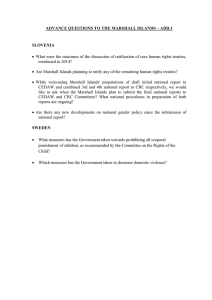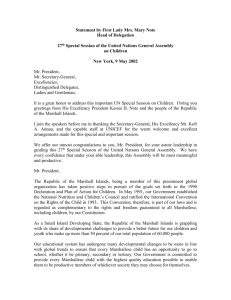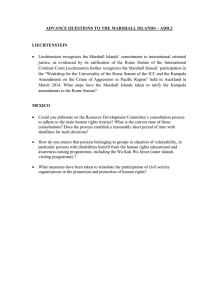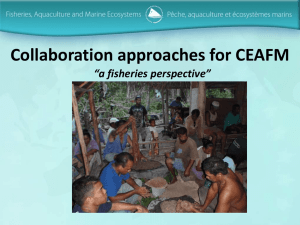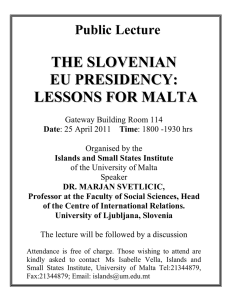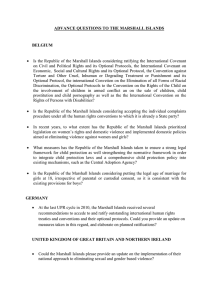Marshall islands
advertisement
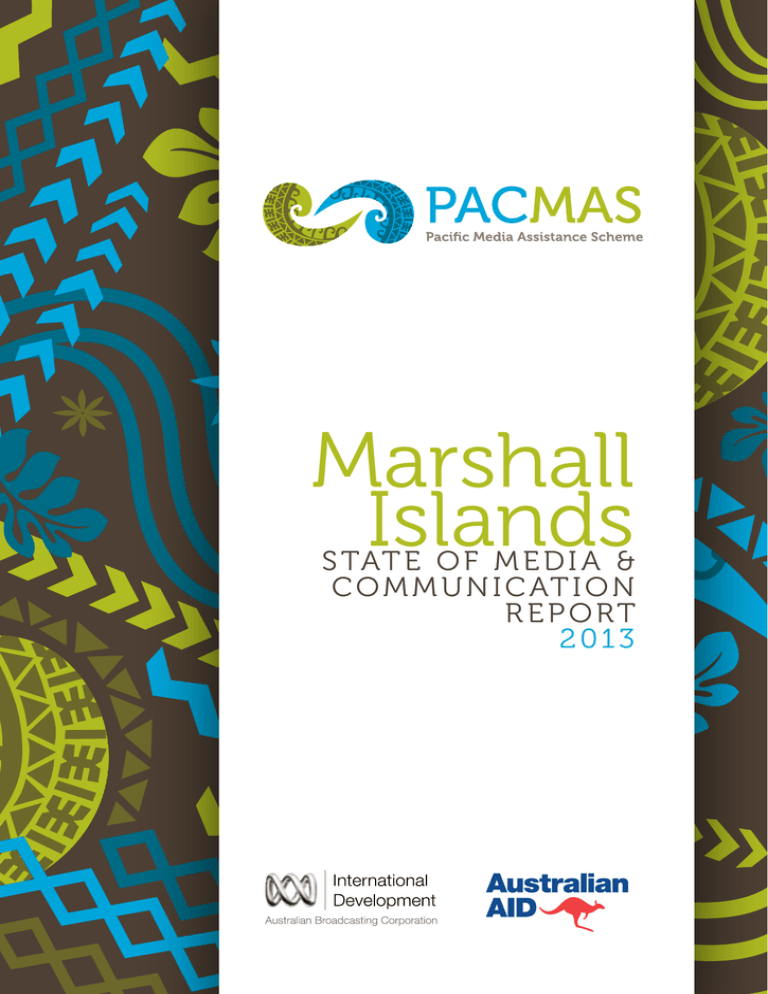
PANTONE 639 PANTONE 583 C88 M40 Y30 K20 PANTONE 411 70% Tint C53 M44 Y100 K27 Marshall Islands S tat e o f M e d i a & C o mm u n i c at i o n Report 2013 Frederick Langmo performs stand-up as part of camera training organised by Oceania Television. Photo by OTV The study was undertaken by Jo Tacchi and Heather Horst at RMIT University, Australia; Evangelia Papoutsaki at UNITEC, New Zealand; and Verena Thomas and Joys Eggins at the University of Goroka, Papua New Guinea. The research data for this report were collected by a team of researchers who conducted both deskbased research and interviews in person, by telephone and/or email while in the Marshall Islands. Researchers included Sandra Kalaihi and Jessica Noske-Turner; Sandra Kailahi completed interviews in the Marshall Islands in October 2012. This report also benefits from verification completed by the Panel of Expertise members. Any opinions represented in this report are those of the authors and research participants and do not necessarily reflect the views of the Australian Government or the Australian Broadcasting Corporation. The findings are presented in three sections: 1. Country Context 2. State of Media and Communications • Media and Communications Platforms • Media and Communications Landscape 3. Summary of Findings 2013 State of Media & Communication Report - Republic of the Marshall Islands Contents Marshall Islands Country Context..................................................................................................................... 2 Key Insights Compact of Free Association with the USA........................................................................................... 2 Funding and Foreign Aid................................................................................................................................ 2 Growth and Limits of Digital Media Usage............................................................................................ 3 State of Media & Communications Media & Communications Platforms........................................................................................................ 3 Television........................................................................................................................................................ 3 Radio.................................................................................................................................................................. 4 Newspaper & Newsletters....................................................................................................................... 5 Online & Mobile Media.............................................................................................................................. 6 Other Communication Platforms........................................................................................................ 6 Media & Communications Landscape............................................................................................................ 7 Policy & Legislation............................................................................................................................................ 7 Media Systems..................................................................................................................................................... 7 PACMAS Strategic Activity: Technicians........................................................................................... 7 PACMAS Strategic Activity: Emergency Broadcast System..................................................... 8 Capacity Building............................................................................................................................................... 8 PACMAS Strategic Activity: Media Associations............................................................................ 9 PACMAS Strategic Activity: TVETS....................................................................................................... 9 Content................................................................................................................................................................... 9 PACMAS Strategic Activity: Climate Change.................................................................................. 10 PACMAS Strategic Activity: NCDs........................................................................................................ 11 Cross-Cutting Issues: Disability, Gender & Youth............................................................................... 11 Summary of Findings.............................................................................................................................................. 12 Policy & Legislation............................................................................................................................................ 12 Media Systems..................................................................................................................................................... 12 Capacity Building............................................................................................................................................... 12 Content................................................................................................................................................................... 12 2013 State of Media & Communication Report - Republic of the Marshall Islands 1 Marshall Islands Country Context The Republic of the Marshall Islands is a Micronesian island nation in the northern Pacific Ocean. The Marshall Islands are in a Free Association with the United States of America (USA) and have had a Compact Agreement with the USA since 1986, which allows for US military use of the Kwajalein Atoll in exchange for assistance and access to US government services. The country consists of 29 atolls, 24 of which are inhabited..12345 Key Insights Table e.1 Basic Country Data Compact of Free Association with the USA The Marshall Islands maintains close relations with the United States under a Compact of Free Association. The first Compact, which came into force in 1986, allows the United States to maintain military facilities in exchange for defense guarantees, development assistance, and visafree access for Marshallese to live, work, study, and obtain health care and social services in the United States6. This has an impact on migration. The USA has a military base on Kwajalein atoll, which also gives people on the island access to the American Forces Television Network. American broadcasts are also available via satellite. The US also influences the Marshall Islands Constitution, with Article 2 guaranteeing freedom of speech much like the First Amendment in the United States constitution. Funding and Foreign Aid Capital Majuro Population3 54,800 Language English Marshallese Gender ratio2 102 males: 100 females Literacy Rates4 94.2% Geography 29 coral atoll islands, land mass of 181 sq. km The Marshall Islands relies on Compact funds for almost 70 per cent of its annual budget. Other donor funding appears to be irregular and limited. For example, Women United Together Marshall Islands (WUTMI) received assistance in 2012 Population Demographics6 Urban pop (% pop)5 from the Canada Fund and the Australian Agency Marshallese 96.8% 72% Other 3.2% for International Development (AusAID), to run their own radio station; however it is currently non-operational due to technical issues with equipment and funding. The ‘Youth-to-Youth’ health program may face a similar issue when the US Embassy acts on its plan to withdraw funding. There appears to be minimal government funding to tackle Non Communicable Diseases (NCDs), and a lack of funding for training that may assist in reducing the current high rates. Seventy-five per cent of government NCD funding is allocated to diabetes and medical evacuations (often gangrene) from outer islands. 1 2011 census 2 July 2012 est.; UNESCAP 2012. Marshall Islands. http://www.unescap.org/stat/data/syb2012/country-profiles/Marshall-Islands.pdf Accessed 27 April 2013 3UNESCO 2012. UIS Statistics in Brief – Marshall Islands. http://stats.uis.unesco.org/unesco/TableViewer/document.aspx?ReportId=289&IF_ Language=eng&BR_Country=5840&BR_Region=40515 Accessed 27 April 2013 4UNESCO 2012. UIS Statistics in Brief – Marshall Islands. http://stats.uis.unesco.org/unesco/TableViewer/document.aspx?ReportId=289&IF_ Language=eng&BR_Country=5840&BR_Region=40515 Accessed 27 April 2013 5UNESCAP 2012. Marshall Islands. http://www.unescap.org/stat/data/syb2012/country-profiles/Marshall-Islands.pdf Accessed 27 April 2013 6The Amended Compact which came into force in 2004 states that the US will continue to provide assistance until 2023, and allows for the continued use by the US ARMY Kwajalein Atoll as a missile test range until 2066 with possible extension to 2086 see http://www.state.gov/r/pa/ei/ bgn/26551.htm 2 2013 State of Media & Communication Report - Republic of the Marshall Islands Figure 1: Media Production Team at Youth to Youth in Health. Photo by Sandra Kailahi, October 2012 Growth and Limits of Digital Media Usage Although radio is currently the most important medium of communication (especially for outer islands), digital media use is on the rise among young people in Majuro and diaspora communities. There are at least two blogs run by young Marshallese about climate change7, and one website8 run by a Marshallese living in California that includes information, news and forums. Several other advocacy organisations use Facebook and YouTube to share photos and videos. However, ‘During a natural disaster, most often than not what you end up using is the oldest technology, which is like the hand radios.’ (MARSHALLS11) State of Media and Communications Media and Communications Platforms Most of the media in the Marshall Islands is restricted to the Majuro Atoll, and the only media outlet with national coverage is the government’s AM radio station. Radio is the most important and diverse media platform across the islands. Access to broadcasting services is limited due to a lack of infrastructure, and blackouts are common. Non Government Organisations (NGOs) have relatively affordable and regular access to radio programming, airtime, and advertise in newspapers, via government and private outlets. In the past, some organisations that were perceived as overtly political have been excluded from the government radio station. There are also several NGOs and civil society groups (women/youth) who produce communications materials. Television The US Army-run Armed Forces Television Network operates on Kwajalein and Ebeye Islands providing broadcasts to US military personnel and civilian contractors and their families. Otherwise, television is available on Majuro only, where there are two competing companies offering cable TV content from the BBC, CNN, Al Jazeera, NHK, and other networks from America, China, and India. One of these two, MHTV, also broadcasts some local videos and photomontages, but doesn’t produce local news. 7 8 See http://www.huffingtonpost.com/mark-stege and http://jkijiner.wordpress.com/ www.yokwe.net 2013 State of Media & Communication Report - Republic of the Marshall Islands 3 Figure 2: Darsy Augustine & John Zedkaia on Camera. Photo by OTV Table e.2 Media and Communication Platforms: Television Platform Organisation Ownership/ Funding Language/ Content Sector Television Marshalls Broadcasting Company (MBC) Owned by Victor Milne and United Micronesia Development Association, managed by RRE (owned by the Reimers family) Provides cable TV to most of Majuro (but none of the outer islands). Commercial MHTV (digital broadcasting station /cable TV) National Telecommunications Authority (NTA), Marshall Islands government is majority shareholder. A second option to access cable TV in Majuro Commercial Armed Forces Television Network (AFRTS) Operated by the US Army Available on Kwajalein and Ebeye Islands to US military personnel and civilian contractors and their families. Government (Foreign) Radio Radio is the most important communication platform in the Marshall Islands, especially for the outer islands. The state-owned radio station, V7AB National, is the only station to have national coverage. The employees at V7AB National are public servants, and the station’s content includes local and international news and music. With the exception of the stations run by the US Armed Forces, all other radio stations are located on Majuro. Local businessmen own V7-Emon, and two other radio stations are run by church groups. The only community radio station in the Marshall Islands is run by WUTMI. It was not operational at the time of writing due to broken transmission equipment. WUTMI perceives some hostility directed towards them by the government, and while there was a period when WUTMI was not given access to airtime on the national government radio station (V7AB), they now have two free programs a week. A music station owned by Ace Broadcasting, V7DJ, was not operational at the time of writing. 4 2013 State of Media & Communication Report - Republic of the Marshall Islands Figure 3: PACMAS and OTV media trainees at the Mariculture. Photo by OTV Table e.3 Media and Communication Platforms: Radio Platform Organisation Ownership/ Funding Language/ Content Sector Radio V7AB National, 1098 AM Owned by the government, run by Marshall Islands Broadcasting Company National coverage, Music, local/ international news, government Government V7BNJ FM, 101.1 Operated by Bukot Nan Jesus (a branch of the Assemblies of God), it is the largest church radio in the Marshall Islands Broadcasts to Majuro only Church V7AA FM, 104.1 Operated by the Baptist Church Broadcasts to Majuro only Church V7M1 FM (or V7-Emon)95.5FM Privately owned by Pacific Media Services (5 local businessmen) Music, local/international news, talk show format Commercial AFN 99.9 (Kwajalein), AFN 101,1 (Kwajalein), AFN 102.1 (Kwajalein) US Armed Forces Available in Kwajalein Foreign (US government) Newspaper and Newsletters The only newspaper in the Marshall Islands is the privately owned Marshall Islands Journal. The government no longer produces the Marshall Islands Gazette (and has not done so for many years). A new newspaper, The Island Voice, was launched, and closed, in 2011. Table e.4 Media and Communication Platforms: Newspaper and Newsletters. Platform Organisation Ownership/ Funding Language/ Content Sector Newspaper Marshall Islands Journal Micronitor News and Printing Co. Inc. Weekly, bilingual (English and Marshallese) paper Commercial 2013 State of Media & Communication Report - Republic of the Marshall Islands 5 Online Media and Mobile Media Information and Communication Technologies (ICTs) are relatively underdeveloped in the Marshall Islands. The National Telecommunications Authority (NTA) has a monopoly on mobile and internet provision, which is said to contribute to higher costs and lower penetration9. Mobile subscription rates are low at 7 per 100 people, and internet use is also low at 3.6 per cent10. Despite these rates, there is small but noticeable online activity, and the Marshall Islands Journal has a website and digital edition (in addition to its weekly print run). There is also a news website and forum run by a Marshallese living in California11, and two youth-run blogs about climate change. The government also has a regularly updated website. Table e.5 Media and Communication Platforms: Online and Mobile Media Platform Organisation Ownership/ Funding Language/ Content Sector Online and email Marshall Islands Journal Micronitor News and Printing Co. Inc. English and Marshallese. News website is updated weekly, digital edition is available by email Commercial Online President’s Office website Government In English, updated regularly at http://www.rmi-op.net/ Government Yokwe Online Run by a Marshallese person living in California Includes news and forums, is updated semi-regularly www. yokwe.net Community/ volunteer Blog by Mark Stege Maintained by Mark Stege as a Huffington Post blog Covers climate change issues http://www.huffingtonpost. com/mark-stege Individual IEP Jeltok Blog by Kathy JetnilKijner Covers climate change issues http://jkijiner.wordpress.com/ Individual WUTMI NGO Has a basic website http://www.wutmirmi.org/ plus a Facebook page and uploads YouTube videos Community Other Communication Platforms NGOs use face-to-face communication and engagement for many of their advocacy activities. A climate change advocate has formed an advisory group of elders who are called upon for advice on climate change. The Youthto-Youth in Health team visits outer atolls to deliver their messages, as does Marshall Islands Conservation. Women United Together Marshall Islands (WUTMI) brings representatives from the different Islands together for their annual conference, which is broadcast live on the NTA’s local channel. WUTMI is also a significant contributor of content, producing posters on domestic violence, newspaper advertisements, DVDs, and YouTube videos of their forums. Table e.6 Media and Communication Platforms: Other Communication Platforms Platform Organisation Language/ Content Sector Other Village Reference Groups Marshallese and English, climate change Community NGOs including Youth-to-Youth in Health, Marshall Islands Conservation and WUTMI General face-to-face communication Community WUTMI Produces a variety of advocacy content including DVDs, posters, ads Community 9At the time of writing the Marshallese government had just agreed to open up the telecommunications market and has entered a grant scheme with the World Bank to address this issue. See Policy and Legislation section of this report. 10UNESCAP Statistics Division, http://www.unescap.org/stat/data/syb2012/country-profiles/Marshall-Islands.pdf 11 2013. Yokwe Online. www.yokwe.net Accessed 27 April 2013 6 2013 State of Media & Communication Report - Republic of the Marshall Islands Media and Communications Landscape This section of the report focuses on the Marshall Islands’ media and communication sector across four key areas: policy and legislation, media systems, capacity building and content. It provides an overview of the state of media across these four Pacific Media Assistance Scheme (PACMAS) components through exploring the six PACMAS strategic areas: Technicians, Pacific Emergency Broadcast Systems, Technical and Vocational Education and Training (TVETs), Media Associations, Climate Change and NCDs. Media Systems includes a focus on Technicians and Pacific Emergency Broadcast Systems (PEBS). Capacity Building includes TVETs and Media Associations. Content looks at Climate Change and NCDs. It provides an overview of media and communication across these areas and aligns them with the PACMAS program components. Policy and Legislation The main policy and legislation in the Marshall Islands includes the Radio Communication Act 1993 [Marshall Islands Revised Code 2004, Title 40, Chapter 3]; the Marshall Islands National Telecommunications Authority Act 1990 [Marshall Islands Revised Code 2004, Title 40, Chapter 1]; and the Political Broadcast Access Act 1966 [Marshall Islands Revised Code 2004, Title 40, Chapter 2]. The communications section of the Ministry of Transportation and Communication registers radio and TV stations but does not take any further role in regulating the media. There is no specific media legislation and no restrictions on media content. There is no self-regulating body or local media council or any specific legislation for community media. In the late 1980s the Micronesian Information Broadcast Association (MIBA) was created, but did not survive. There is an Ethics in Government Act, Title 3, Chapter 17 of the Marshall Islands Revised Code, which government media employees are obliged to follow, but there is no industry-wide code of ethics for media. The Bill of Rights, Article II, Section 1(1) protects freedom of speech and of the press, and the government is reported to respect these rights in practice. It seems relatively simple to obtain a license; a general business license is needed as well as approval of frequency for broadcasting. The Political Broadcast Act states that any political candidate must have access to free airtime on government broadcasters, with a minimum allocation of 15 minutes. However, the local women’s advocacy NGO, WUTMI, describes some difficulty in getting approval for their radio station, and later for airtime for their radio program on the government radio station. Although there is no Freedom of Information (FOI) legislation, government offices do share information; however most government offices do not have policies in place, so actually obtaining information is said to be ad hoc. Telecommunications legislation gives the privately owned but government controlled company the National Telecommunications Authority (NTA) a monopoly on telecom services in the Marshall Islands. The Marshall Islands government has a 65 per cent shareholding in the NTA. The Marshallese government and the World Bank have agreed on a grant scheme for opening up the telecom sector to competition, with the World Bank providing the Marshall Islands government with an initial conditional US$3 million grant in March 201312. Media Systems Media systems take into consideration technical skills, support and infrastructure. It also explores emergency broadcast systems and experience from past disasters in the Marshall Islands. PACMAS Strategic Activity: Technicians Technical support is ad hoc and dependent upon personal and professional relationships. For example, a technician at V7AB has connections with an engineer at Radio Fiji, and is able to call on him for advice. Technicians report contacting equipment providers, which offer 24-hour online support services. The National Telecommunications Authority (NTA) is a member of the Pacific Islands Telecommunications Association (PITA) and is in regular communication with them. The NTA is also a member of the International Telecommunications Union (ITU). At the time of writing, technicians at the NTA were supported by a Japanese volunteer, provided through the Japan International Cooperation Agency (JICA). All technicians have access to online manuals. Issues regarding equipment problems in disaster situations have not been highlighted, possibly due to the absence of severe disasters in recent decades. 12 World Bank. 2013. World Bank and Marshall Islands launch new strategy to strengthen partnership. http://www.worldbank.org/en/news/press release/2013/03/19/world-bank-marshall-islands-launch-new-strategy-to-strengthen-partnership Accessed April 2013 2013 State of Media & Communication Report - Republic of the Marshall Islands 7 PACMAS Strategic Activity: Emergency Broadcast System The Chief Secretary’s Office takes the lead on disaster management, becoming a central liaison point for the local-level governments. The current plan is reportedly held within the Disaster Management Committee and Chief Secretary’s Office. At the time of writing there was no official public document, and the plan is reported to be under ‘review’ (MARSHALLS09). The few documents that are available13 do not outline the processes for communication in much detail. The Hyogo Framework for Action14 describes the work that is required from across sectors (including governments, international agencies, disaster experts) to reduce disaster risks. The framework discusses a series of constraints regarding effective disaster management processes, including a lack of political and social interest, partly because the Marshall Islands has little recent experience with natural disasters. The 1997 National Disaster Management Plan description of dissemination of messages suggests a reliance on the government broadcaster, V7AB. The Hyogo Framework for Action report also identified a dependence on radio, despite issues such as power shortages, coverage gaps, and limited access to radio receivers. The isolation of many of the outer islands was noted as a particular challenge. According to the NTA, the existing technology for mass SMS messaging is not currently used. This is because the law specifies that only the Chief Secretary has the power to communicate emergency information. Other stakeholders report a general lack of coordination by the Office of the Chief Secretary. A lack of clarity of roles and responsibilities mean that other resources are not integrated into disaster responses (e.g. MIMRA’s [Marine Resources Authority] vessels that could be used in a disaster are not included in this plan). There are some sections of the National Disaster Management Plan that outline ways of increasing public awareness through radio, educational materials, visits to schools, collaborations with NGOs and via community leaders. One research participant was able to confirm that some pre-recorded awareness videos have been broadcast on the local TV channel. Capacity Building Capacity building includes an understanding of the level of qualifications among existing media and communication practitioners, training and capacity building support and organisations providing such support. It also takes into consideration media associations and TVETs in the Marshall Islands. Research participants consistently stated there was a need for training and capacity building and that local training would be preferred as most organisations have small staff numbers and could not afford to have them absent from work for extended periods. In some cases training has been undertaken at the Secretariat of the Pacific Community (SPC) Media Centre in Nauru as well as in Fiji and Taiwan, but this has been limited. Similar to some other Pacific countries included in this study15, there does not seem to be much interest in the Marshall Islands in undertaking journalism courses. The preference is for law and medicine, in part because the salaries for journalism graduates are poor. Journalism is very much a vocational career choice. There are a few opportunities for internships with the newspaper. Journalists with a degree are estimated to be less than 10 per cent of government and community journalists and less than 30 per cent of commercial journalists. Although WUTMI members do not have any formal training they have initiated a number of positive community projects such as the Women in Business Development Project (WBDP), which provides a business network and information on how to cost and market products. In addition, WUTMI has held a conference and workshops for artisans, marketers and trainers in conjunction with Samoan WBDP members. WUTMI’s approach is to ‘just kind of do it, we don’t really have training. We didn’t have training in media, we didn’t have training on going out and doing awareness, we just kind of got into it and did it.’ (MARSHALLS13). In effect, they have learned by trial and error. 13 Government of the Republic of the Marshall Islands. 2007 National Action Plan for Disaster Risk Management 2008-2018 http://www. pacificdisaster.net/pdnadmin/data/documents/5610.html, National Disaster Management Plan (1997 revised edition) http://www.drrgateway.net/ sites/default/files/marshall_islands_MGMT_plan_1997.pdf Accessed 27 April 2013 14UN General Assembly (Resolution A/RES/60/195) following the 2005 World Disaster Reduction Conference; Office of the Chief Secretary. 2011. Marshall Islands National Progress Report on the implementation of the Hyogo Framework for Action (2009-2011) http://www.preventionweb.net/ files/21399_mhl_NationalHFAprogress_2009-11.pdf Accessed 27 April 2013 15 See for example, the report on Tonga in this series 8 2013 State of Media & Communication Report - Republic of the Marshall Islands Figure 4: Diabetes Wellness Centre, Photo by Sandra Kailahi One Talk Enterprises Canada did provide one week of training on how to operate the radio, and also set up the antenna for WUTMI’s radio station. However, the station is currently not in operation due to lack of funding, and technical issues. The Marshall Islands Conservation Society was able to send one member to undertake two weeks’ media training in Pohnpei (Federated States of Micronesia) with the Micronesian Conservation Trust. Technicians at V7AB receive on-the-job training and do not have access to overseas formal training. In contrast, NTA technicians mostly receive training abroad. PACMAS Strategic Activity: Media Associations The Micronesian Information Broadcast Association (MIBA) was created in the late 1980s but did not survive. According to recent reports from Freedom House, Marshallese journalists are associated with a newly formed Micronesian Media Association. Our findings indicate this is not the case. As one research participant observed, ‘Somebody has to take the lead in trying to get a small organisation, even though it’s a small country but somebody has to take the lead, get a small media organisation here’ (MARSHALLS10). PACMAS Strategic Activity: TVETS There are no TVETs in the Marshall Islands and no journalism-specific courses at either the College of the Marshall Islands (CMI) or the University of the South Pacific’s (USP) Extension Centre. Students attending USP in Majuro can, however, transfer to the USP campus in Suva to undertake programs in journalism. Content ‘The radio is the best way to reach people because most people are illiterate … in Marshallese and English … most don’t know how to write in Marshallese. It is an oral tradition. It's also why YouTube is a successful form of communication.’ (MARSHALLS01) Media content focuses on communication platforms and programs and ways to address issues related to climate change and NCDs. Climate change and NCDs are two strategic activities in the PACMAS program. 2013 State of Media & Communication Report - Republic of the Marshall Islands 9 A recent survey conducted in 2011 found that every household in the Marshall Islands has at least one transistor radio and ‘radio is the most important format’ (MARSHALLS10). WUTMI is a significant contributor to communication for development (C4D) content. WUTMI has started working on projects that focus on issues affecting women and women’s empowerment in the Marshall Islands, such as a survey to measure the prevalence of violence against women, projects on Parents as Teachers, substance abuse, voter education, gender equality and women in leadership. They also have a project on “turtle tagging” which includes training observers on how to handle, measure, tag and document turtles with metal tags donated by the Secretariat of the Pacific Regional Environment Programme (SPREP) in order to share data with SPC. A core goal of WUTMI is to revive Marshallese customs, culture and language. As previously discussed, WUTMI’s communication networks extend to all islands. Content produced by WUTMI includes posters, newspaper advertisements, DVDs, YouTube videos, and a Facebook page with information and photos. The Marshallese learn about domestic violence from WUTMI advertisements, which are believed to be an effective form of communication because they are easy to read. As a result, women often call WUTMI before the police because there is a perception that ‘a lot of people just think that we’re the ones to help them’ (MARSHALLS13). WUTMI hosts two radio programs on V7AB; on Friday evenings they discuss all their projects, and the Saturday afternoon show is dedicated to the Parents as Teachers project. WUTMI are able to run these programs free of charge. PACMAS Strategic Activity: Climate change As a low-lying group of atolls, the Marshall Islands are susceptible to storm surges or king-tides and typhoons as well as other climate change effects such as drought. The most pressing issue is the ongoing access to drinking water. The Marshall Islands has developed several policies on climate change that include proposals for government activities. The communications-related actions listed include a clearing-house (making data and information available), and a communications plan (a basic public relations campaign document outlining target audiences, key messages, media strategies etc). There is some reference to increasing participation, but very little detail on plans for Communication for Development (C4D) projects. Although the level of awareness of climate change issues is considered to be ‘medium to high’ on the main islands, it is ‘low to medium’ on outer islands. Climate change disproportionately affects women and families on the outer islands. Currently, climate change is not included in school curriculums and it was suggested by one research participant that perhaps some Marshallese did not perceive it as an important issue ‘because we don’t really talk about it on the radio and people don’t realise’ (MARSHALLS10). There are several active NGOs involved in climate change advocacy. WUTMI is involved in a number of climate change programs including the Pandanus festival that celebrates the important role of the Pandanus in Marshallese culture and involves collecting and handing out seeds/seedlings to be planted, especially in coastal areas, to stop soil erosion. The Just Act Natural, Youth to Youth centre, 350.org and Marshall Islands Conservation Society provide some community programs communicating information about climate change. Some young people are outspoken about climate change and have started their own blogs16. 16 See http://www.huffingtonpost.com/mark-stege and http://jkijiner.wordpress.com/ 10 2013 State of Media & Communication Report - Republic of the Marshall Islands PACMAS Strategic Activity: NCDs ‘Everybody thinks [diabetes] is a natural death instead of something that is preventable. I think that’s where we have problem [in] health services addressing it, […] it’s only us that … are thinking that it’s a crisis, but the community’s accepting it.’ (MARSHALLS07) At the time of writing, the Marshall Islands Government was considering declaring a state of emergency in relation to NCDs. The Marshall Islands has several policies addressing NCDs including a National Nutrition Action Plan and a National NCD Action Plan. In comparison to other Pacific countries, the Marshall Islands have one of the lowest rates of fruit and vegetable intake, and have low rates of physical activity. Like most of the Pacific islands region, obesity is an issue along with diabetes and high cholesterol17. Food is a significant issue as processed foods are cheap and accessible. Brown rice is three times more expensive than white rice, and vegetables are expensive (MARSHALLS08). A number of research participants believe communities need to re-learn how to cultivate healthy produce, in particular fruit and vegetables. In addition, research participants report that there needs to be more intensive training that targets lifestyle choices and changes, and teaches people how to self-manage their health. There appears to be a low level of public awareness about NCDs. Groups working to help communities include WUTMI and the independently run Diabetes Wellness Centre. Radio is also used to communicate messages. The Health Department hosts a weekly radio program and writes information for inclusion in the newspaper. Some NCD programs have been aired on the local TV channel. The Youth-to-Youth health program engages youth as peer educators and has a weekly 30-minute radio show on V7AB. Crosscutting Issues: Disability, Gender and Youth The crosscutting issues explore how gender, youth and disability engage with and are represented within the media and communication environment in the Marshall Islands. Disability was not mentioned as a key issue by interviewees and there were no reports of disability programs or initiatives using media and communication platforms18. Gender did not emerge prominently in the interviews. However, WUTMI are actively involved in promoting women’s empowerment and organising around women’s issues using media and communications platforms; they also provide an outline of their projects on the website: http://www.wutmirmi.org/. There is also an understanding that climate change disproportionately affects women and families, especially those on the outer islands. Youth are viewed as central to the future success of the Marshall Islands and several organisations advocate with and for young people, including Youth-To-Youth, Just Act Natural and 350.org. As 80 per cent of Marshallese youths are pre-diabetic, youth health is a serious concern. Youth-to-Youth is among the leading youth health organisations engaging with young people on this issue, often in collaboration with WUTMI. Just Act Natural informs youth about environmental issues such as climate change, sea level rises, and health. They run workshops on climate change including in the outer islands. The 350 Committee - 350.org - uploads interviews with young people indicating what they can do for the future of their country. 17 Healthy Pacific Lifestyle Section, Public Health Division, Secretariat of the Pacific Community . 2010. NCD Statistics for the Pacific Islands Countries and Territories, http://www.spc.int/hpl/index.php?option=com_docman&task=doc_download&gid=67 Accessed 27 April 2013 18This does not mean disability does not exist as a prominent issue, but does reflect the observations of those who took part in this research, who work in key media and other relevant organisations, as detailed in other parts of the Baseline report. 2013 State of Media & Communication Report - Republic of the Marshall Islands 11 Summary of Findings Together with an active civil society, the media and communication environment in Marshall Islands is dynamic, but faces challenges caused by scale and its dispersed audiences. The main findings across the four PACMAS component areas of policy and legislation, media systems, capacity building and content are summarised below: Policy and Legislation • • • • • The Ministry of Transportation and Communication is responsible for registering broadcasting stations. Freedom of speech and the press are guaranteed in the Bill of Rights. There is no media self-regulating body, and no media association. There is no FOI legislation. Telecommunications are currently a monopoly but the government is working with the World Bank to open the market to competition. Media Systems • Technicians primarily use personal and professional networks for assistance. Equipment providers are also a source of advice. NTA is a member of PITA and ITU. The National Disaster Management Plan is currently under review. There is a lack of clarity of the roles and responsibilities in a disaster, and a perceived lack of political will. Some available communication technologies are not being integrated. • • • • Capacity Building • • • • NGOs have been able to access limited opportunities for media and communications training. Most technicians are trained on the job. There is no local media association. There are no local TVET courses relating to media and communication. Content • • • • Radio remains an important platform in the Marshall Islands. WUTMI is a significant contributor of C4D content. Several NGOs are active advocates regarding climate change. Government departments and NGOs use radio for NCD communication. 12 2013 State of Media & Communication Report - Republic of the Marshall Islands 2013 State of Media & Communication Report - Republic of the Marshall Islands Further information: http://www.pacmas.org/ http://www.abcinternationaldevelopment.net.au/
